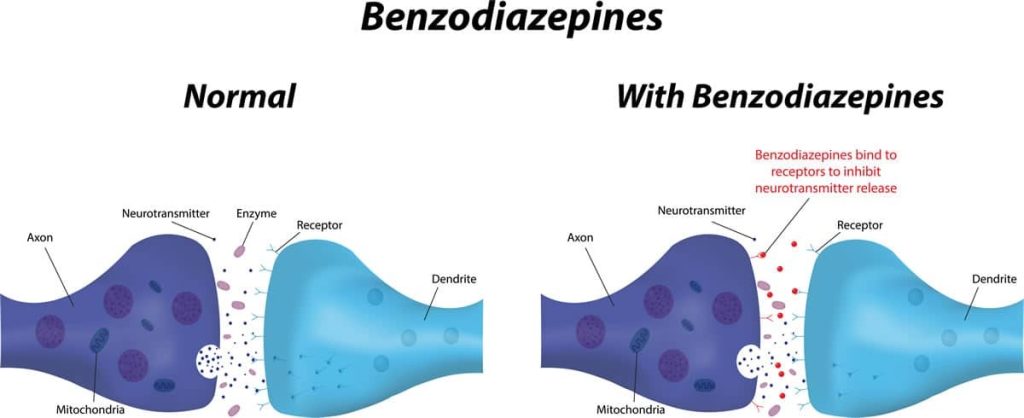Benzodiazepines are a class of widely prescribed psychoactive drugs used to treat conditions like anxiety, insomnia, seizures, muscle spasms, and alcohol withdrawal. Some well-known benzodiazepines include medications like Xanax (alprazolam), Valium (diazepam), and Klonopin (clonazepam). But despite their prevalence, many people do not understand exactly how do benzodiazepines work in the body and brain to produce their therapeutic effects. Gaining insight into the mechanism of action of these drugs provides clarity on how do benzodiazepines work to affect the central nervous system and generate sedative, hypnotic, anti-anxiety, anticonvulsant, and muscle relaxant results.
Benzodiazepines act on the central nervous system by enhancing the effects of the neurotransmitter gamma-aminobutyric acid (GABA) at the GABA-A receptor. Essentially, they amplify the anxiety and stress-reducing action of the body’s natural GABA. It is this modulation of the receptor and subsequent enhancement of GABA’s inhibitory function that underlies how do benzodiazepines work. While different benzodiazepines have distinct potencies, durations, and therapeutic profiles, they all work by binding to GABA-A receptors and increasing the inhibitory effects of GABA.
Understanding the mechanism provides clarity on how do benzodiazepines work to produce their versatile clinical effects.
Binding to the GABA-A Receptor
Benzodiazepines act on the central nervous system by enhancing the effects of the neurotransmitter gamma-aminobutyric acid (GABA) at the GABA-A receptor. GABA is the brain’s major inhibitory neurotransmitter, meaning it reduces neuronal excitability and activity. The GABA-A receptor has a site where GABA binds as well as a site where benzodiazepines bind, known as the benzodiazepine site.
When a benzodiazepine molecule binds to the benzodiazepine site, it causes a conformational change in the GABA-A receptor structure that increases its affinity for GABA. This means that when GABA then binds to its site, the inhibitory effects are enhanced.
Amplifying GABA’s Activity
Essentially, benzodiazepines amplify the anxiety and stress-reducing action of the body’s natural GABA. For example, amplified GABA activity inhibits certain brain areas to reduce anxiety. Enhanced inhibition of neuronal excitability can also stop seizures. In the spinal cord and periphery, greater GABA effects relax muscles. Sedation occurs from amplified inhibition across multiple regions.
Therapeutic Effects
While different benzodiazepines have distinct potencies, durations, and subtype affinities, they all work by binding to GABA-A receptors and modulating GABA activity. Subtle differences in their interactions with subunits of the GABA-A receptor explain their varied therapeutic profiles.
In Summary
Benzodiazepines attach themselves to a distinct site on GABA-A receptors, increasing the receptor’s affinity to the neurotransmitter GABA. The resultant upsurge in GABA’s natural calming and inhibitory activities yields the well-known anti-anxiety, anticonvulsant, muscle relaxant, hypnotic, and sedative impressions of these medications. With the abovementioned explanation on how do benzodiazepines work through binding and modulation of GABA-A receptors, you are now in a position to appreciate how these popularly prescribed medications induce positive effects on the CNS.
Even though different benzodiazepines have different potencies, durations, and specific subtype affinities, their common mode of operation based on positive allosteric modulation of GABA activity underpins their multi-dimensional clinical use. It must be noted that benzodiazepines do not replace GABA but simply enhance its natural inhibitory roles in the entire body and brain. It is this custom working mechanism that responds to how do benzodiazepines work to depress the synaptic transmissions creating sedative, anxiety alleviating, anti-seizure, and muscle-relaxing impressions among others. Understanding the action of benzodiazepines in enhancing GABA inhibition prospects a clearer comprehension of how do benzodiazepines work and their extensive actions on the CNS.
